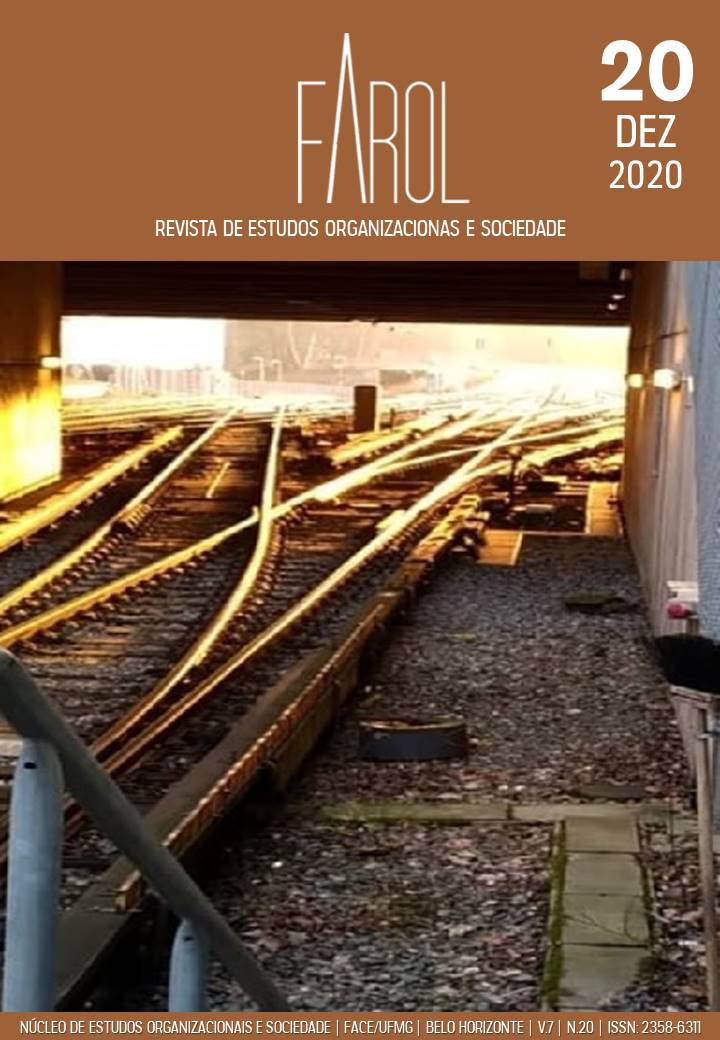ASSEMBLAGE SOCIOMATERIAL: MAKING OF DE UMA PRODUÇÃO AUDIOVISUAL INDEPENDENTE
https://www.youtube.com/watch?v=GjhLu-7AZjo
DOI:
https://doi.org/10.25113/farol.v7i20.6434Palavras-chave:
Vídeo. Métodos Visuais. Sociomaterialidade. Criatividade. Audiovisual.Resumo
Neste artigo, apresento a produção de um vídeo resultado da produção de dados etnográficos de uma produção de um curta-metragem de ficção desenvolvido por jovens estudantes de comunicação, participantes de um projeto de extensão universitária de uma universidade pública. À luz da Teoria Ator-Rede, a pesquisa voltou atenção para identificação de práticas sociomateriais das ações criativas. Ao seguir por essa lente teórica, foi recorrido o método de vídeo para captar as interações envolvidas nos processos criativos. Diante dos desafios do método visual, tem-se que a produção e análise de vídeo colaborou para o rigor e potencialidade de novas perspectivas interpretativa em pesquisas qualitativas nos Estudos Organizacionais. A produção vai ao encontro de um olhar sensível e estético da linguagem cinematográfica que converge com a virada visual e material.
Referências
Boxenbaum, Eva, Jones, Candace, Meyer, Renati E., & Svejenova, Silviya. (2018). Towards an articulation of the material and visual turn in organization studies. Organization Studies, 39(5-6), 597-616.
Davel, Eduardo P. B., Fantinel, Letícia. D. & Oliveira, Josiane S. (2019). Etnografia audiovisual: potenciais e desafios na pesquisa organizacional. Organizações & Sociedade, 26(90), 579-606.
Deleuze, Gilles (2018a) Cinema I: a imagem-movimento. São Paulo: Editora 34.
Deleuze, Gilles (2018b) Cinema II: a imagem-tempo. São Paulo: Editora 34.
Duff, Cameron & Sumartojo, Shanti (2017). Assemblages of creativity: material practices in the creative economy. Organization, 24(3), 418-432.
Hindmarsh, Jon & Llewellyn, Nick (2016). Video in cociomaterial Investigations: A solution to the problem of relevance for organizational research. Organizational Research Methods, 21(2), 412-437.
Hussenot, Anthony & Missonier, Stéphanie (2010). A deeper understanding of evolution of the role of the object in organizational process: the concept of “mediation object”. Journal of Organizational Change Management, 23(3), 269-286.
Jarrett, Michael & Liu, Feng (2016). “Zooming with”: a participatory approach to the use of video ethnography in organizational studies. Organizational Research Methods, 21(2), 366-385.
Latour, Bruno (2011). Ciência em ação: como seguir cientistas e engenheiros sociedade afora. São Paulo: UNESP.
Latour, Bruno (2012). Reagregando o Social: uma introdução a Teoria Ator-Rede. Salvador: EDUFBA/EDUSC.
Mason, Katy (2010). Market sensing and situated dialogic action research (with a video camera). Management Learning, 43(4), 405-425.
Mengis, Jeanne, Nicolini, Davide & Gorli, Mara (2016). The Video Production of Space: How Different Recording Practices Matter. Organizational Research Methods, 21(2), 288-315.
Orlikowski, Wanda J. (2007). Sociomaterial Practices: Exploring Technology at Work.
Organization Studies, 28(9), 1435-1448.
Reckwitz, Andreas (2002). Toward a Theory of Social Practices: A Development in Culturalist Theorizing. European Journal of Social Theory, 5(2), 243-263.
Tanggaard, Lene (2013). The sociomateriality of creativity in everyday life. Culture and Psychology, 19(1), 20-32.
Toraldo, Maria L., Islam, Gazi & Mangia, Gianluigi (2016). Modes of Knowing: Video Research and the Problem of Elusive Knowledges. Organizational Research Methods, 21(2), 438–465.
Whiting, Rebecca, Symon, Gillian, Roby, Helen & Chamakiotis, Petrus (2016). Who’s Behind the Lens?: A Reflexive Analysis of Roles in Participatory Video Research. Organizational Research Methods, 21(2), 316–340.
Zundel, Mike, MacIntosh, Robert & Mackay, David (2016). The Utility of Video Diaries for Organizational Research. Organizational Research Methods, 21(2), 386-411.
Downloads
Publicado
Edição
Seção
Licença
Copyright (c) 2020 José Edemir da Silva Anjo

Este trabalho está licenciado sob uma licença Creative Commons Attribution 4.0 International License.
Assume-se que em qualquer das modalidades de contribuições aceitas pela Farol – Revista de Estudos Organizacionais e Sociedade, ao submeter um trabalho, o(s) autor(es) se reconhece(m) como detentor(es) do direito autoral sobre ele e autoriza(m) seu livre uso pelos leitores, podendo ser, além de lido, baixado, copiado, distribuído, adaptado e impresso, desde que seja atribuído o devido crédito pela criação original. Em caso de aprovação do trabalho para publicação, os direitos autorais (inclusive os direitos de tradução) são exclusivamente do(s) autor(es).
Os autores devem concordar com os seguintes termos relativos aos Direitos Autorais:
a. Autores mantém os direitos autorais e concedem à revista o direito de primeira publicação, com o trabalho simultaneamente licenciado sob a Licença Creative Commons Attribution que permite o compartilhamento do trabalho com reconhecimento da autoria e publicação inicial nesta revista.
b. Autores têm autorização para assumir contratos adicionais separadamente, para distribuição não-exclusiva da versão do trabalho publicada nesta revista (ex.: publicar em repositório institucional ou como capítulo de livro), com reconhecimento de autoria e publicação inicial nesta revista.
c. Autores têm permissão e são estimulados a publicar e distribuir seu trabalho online (ex.: em repositórios institucionais ou na sua página pessoal) a qualquer ponto antes ou durante o processo editorial, já que isso pode gerar alterações produtivas, bem como aumentar o impacto e a citação do trabalho publicado (Veja O Efeito do Acesso Livre).

